My Greatest Achievement in Croatia: a Seat on the Dalmatian Bench
March 15, 2023 - Life in Dalmatia is amazing. The pace of life, the polako, the pomalo, the laganini.
Over the years, I became fixated with the wise elders of Jelsa, as they gathered each evening on the white bench under the Mayor's office to discuss the weighty matters of the day.
I can't explain it but I became a little bit obsessed, and all I wanted was an invitation to sit with them on the bench, an honour that is never bestowed upon foreigners, I was assured.
And then one day, after 13 years...
****
You can subscribe to the Paul Bradbury Croatia Expert YouTube channel here.
What is it like to live in Croatia? An expat for 20 years, you can follow my series, 20 Ways Croatia Changed Me in 20 Years, starting at the beginning - Business and Dalmatia.
Follow Paul Bradbury on LinkedIn.
Croatia, a Survival Kit for Foreigners is now available on Amazon in paperback and on Kindle.

Jelsa Trail Race to Showcase UNESCO Heritages of Hvar Island
March 15th, 2022 - An exciting event has been announced by the Jelsa Tourist Board: the first trail running race to take place in this part of Hvar island
The recently announced Jelsa Trail is a bit different than your average trail race. Namely, it will retrace the route of the renowned procession Za križen (Behind the cross), which takes place every Maundy Thursday on Hvar island. The race is scheduled for Saturday, April 23rd, ten days after the traditional procession.
And what a setting for a trail race! Hvar island boasts no less than six UNESCO heritages, Za križen being one of them. You’ll get to discover a few more as the immensely scenic trail takes you through olive groves and vineyards, with cerulean waters of the Adriatic as a backdrop. The route runs through the Stari Grad Plain and along numerous dry stone walls, both UNESCO heritages.

Participants can compete in one of three categories, all endearingly named after a few local favourites:
Srdelica (Sardine) - 5 km, +260 m
The shortest and easiest route Srdelica is beginner-friendly and a perfect choice for those who’d prefer to participate in a more casual manner, soaking in the sights while they walk the trail at a comfortable pace. The trail starts and ends on the waterfront in Jelsa, in the meantime offering wonderful views of island scenery, including the splendid view from the ancient tower Tor. There won’t be an aid station on this trail, and the time limit to finish the race is 2 hours.
Škarpina (Scorpionfish) - 11 km, +420m
This route is beginner-friendly, but also suitable for more experienced runners. The trail starts and ends on the waterfront in Jelsa. After the initial ascent and passing by the tower Tor, the trail continues to run through olive groves and vineyards to the picturesque Pitve village, then back to Jelsa. The trail will have one aid station in Pitve (7km mark), with 3 hours allowed to finish the race.
Šanpjer (John Dory) - 20 km, +620m
The longest route requires a higher level of physical fitness, but isn’t technically challenging. Like the other two, the Šanpjer trail starts and ends on the waterfront in Jelsa. After they pass by the ancient tower Tor, runners will head to Pitve and then follow the route of the renowned procession Za križen. The trail runs through gorgeous places in the environs of Jelsa: Pitve, Vrisnik, Svirče, Vrbanj and Vrboska. Two aid stations will be set up on this route, in Pitve (7km mark) and Vrbanj (12km mark). Four hours are allowed to finish this route, with an added time limit halfway through - racers are allowed 2 hrs 15 mins to reach the checkpoint in Vrbanj.
Sweet and salty snacks will be offered at the aid stations, together with fruit, water and juice. After the race, you can look forward to a proper Dalmatian feast in Jelsa, complete with klapa singing.
The winners will be awarded medals in the shape of Hvar lace, another iconic Hvar feature to bear a UNESCO title.
Interested? You can register for the race on Stotinka.hr - everyone who pays the entry fee before April 14th gets a t-shirt and a glass water bottle for free, both adorned with the Jelsa Trail logo.
Jelsa Becomes the First International Dark Sky Community in Southern Europe
February 28th, 2022 - With its dark night sky now officially certified, the town on Hvar island is set to become a notable astrotourism destination
We recently reported that considerable efforts were being made on Hvar island to decrease light pollution, as part of Jelsa Municipality’s bid to become an International Dark Sky Community.
The International Dark-Sky Association (IDA) has now granted the coveted title to Jelsa, making it the first International Dark Sky Community in Croatia and southern Europe. Jelsa is also the 37th local self-government unit in the world to bear the prestigious title, reports Morski.hr.
The International Dark Sky Community is a title given to local communities that have shown outstanding commitment to dark sky conservation through the implementation of lighting policies, education on dark sky conservation, and citizen support for the initiative.
‘Jelsa Municipality has set a high standard that should be followed by other local governments in your country and this region of the world. We’re honoured to bring attention to Jelsa as a prominent leader in setting an example of how the proper use of lighting benefits people's well-being, as well as the night environment in our communities and beyond’, said the International Night Sky Protection Programme Director Ashley Wilson.
The process of declaring Jelsa an International Dark Sky Community was set in motion by the Jelsa Tourist Board Director Marija Marjan, and the procedure and activities related to the bid were managed by the Croatian Astronomical Union. In the past two years, the municipality has swapped 82% of its unprotected public lighting for fully protected 3000K lighting in accordance with IDA requirements.
The project was implemented over the course of a year, and it involved numerous activities ranging from public telescope observations, lectures, exhibitions, events and astronomy schools for elementary school students to the development of a five-year work plan and environmental lighting guidelines.
Jelsa’s bid was submitted in December last year, and once the additional conditions required by the IDA were fulfilled, the municipality was granted the title of an International Dark Sky Community.
The International Dark Sky Places is an initiative launched in 2001 as a non-regulatory and voluntary programme meant to encourage communities, parks and protected areas around the world to preserve and protect the natural night sky through the adoption of effective lighting policies, environmentally responsible outdoor lighting, and education.
‘Careless use of artificial lighting can disrupt entire ecosystems, have an adverse effect on human health, unnecessarily waste money and energy, considerably contribute to climate change, and obstruct our view and connection to the universe we live in. Jelsa joins the international community of more than 195 protected areas that have made exceptional contributions to the protection of the dark sky from light pollution, and is well on its way to becoming the first serious destination for astrotourism in Croatia’, stated Jelsa Tourist Board.
Places that are known for dark night skies, especially those destinations that have received official certification in this regard, are extremely rare and attract amateur astronomers from all over the world. Citizens of countries that are struggling with light pollution, such as Germany, France, Spain and Italy, constantly seek out locations that will allow them to enjoy the dark night skies.
A Croatian island now joins the list of such locations, with Jelsa officially certified as an ideal location for night sky watching. As such, it will surely attract a new group of tourists, who will no longer have to travel to the Canary Islands to gaze at the night sky.
Young Hvar Locals Dissatisfied with New Vrboska Bridge and 'Headstrong' Mayor
February 27, 2022 - Young Hvar locals have expressed their dissatisfaction with the new Vrboska bridge and their 'headstrong' mayor, prompting a response from mayor Nikša Peronja.
Vrboska, a picturesque village within the Jelsa Municipality, located in a deep bay in the northern part of Hvar island, is in the spotlight after the local youth, dissatisfied with the appearance of the new bridge, told the public that they had enough of their headstrong mayor.
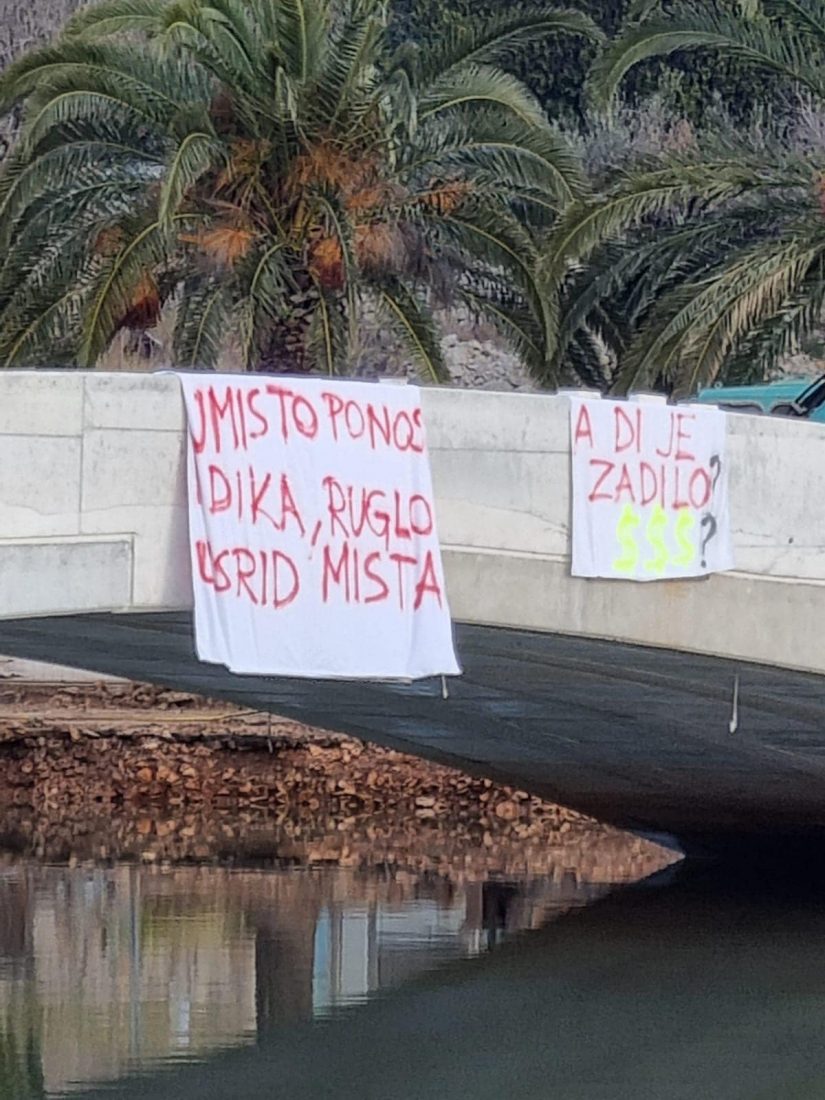
Reader
"The dissatisfaction of the people of Vrboska has been going on for some time; it is not from yesterday. This bridge is just a drop in the bucket," a 63-year-old resident said for Morksi.hr, noting that he would be happy to share the whole story, but it would then take us hours of conversation, and he doubts that the media coverage of all the real problems facing the people of Vrboska would change anything.
"Vrboska does not need a road bridge at all. It is in the shape of a horseshoe, and the road was built in the 1960s and leans on that horseshoe. So this bridge could easily have been the most common wooden pedestrian bridge, and not a bridge for road traffic," the local adds.

Reader
Morski learned that the price of the concrete bridge jumped from the original 1.8 to more than 4 million kuna. The bridge is almost a meter higher than the original project, selected by a seven-member jury five years ago, including SDP Jelsa mayor Nikša Peronja, who addressed the dissatisfied residents last week on his Facebook profile.
"The bridge will be completed approximately two weeks before Easter, and we have coordinated this with the contractor, designers, and all other participants in the project. I know that various stories and theories have appeared in Vrboska; most are completely unfounded and have no basis in reality. You must understand that it is the worst for me because I have objections, not the designer who had to change the project several times. We had a problem with mud at the bottom and even a problem with wells that did not show the correct condition of the soil. We encountered a whole series of problems, and the construction of the bridge took some time," said Peronja.
According to the mayor, the old bridge was statically defective and thus unsafe to use, so it was out of order. However, he is convinced that the locals of Vrboska will be satisfied in the end.
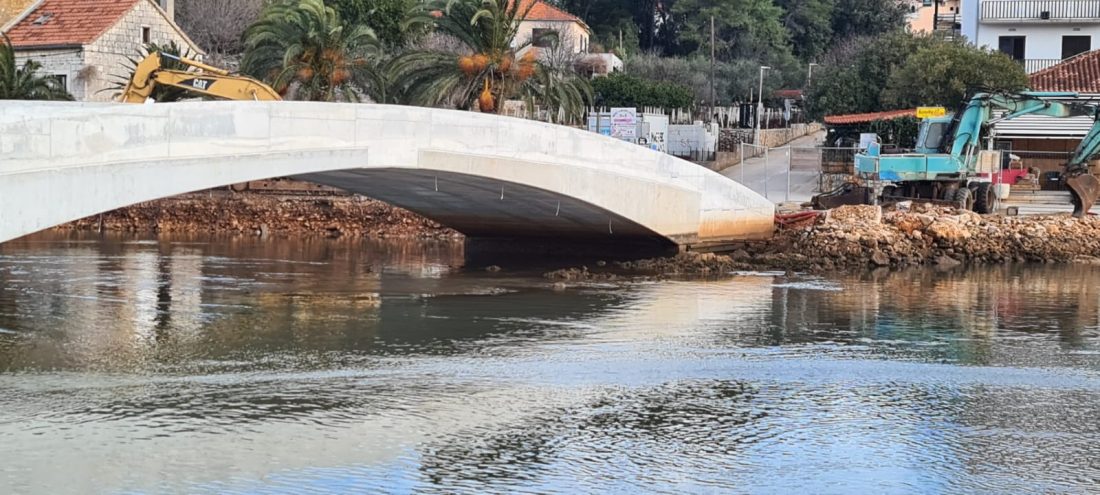
Reader
The locals of Vrboska say the municipality makes good money - both from the sale of land and from utilities. But some of them claim that little is being invested in this settlement with about 500 permanent residents who would like to get, for example, public transport and bus stops. In addition, the residents of Vrboska would like to get a new cemetery with a morgue, and the mayor promises that this wish will soon be fulfilled.
"You have to understand that when I came, there was almost nothing, we started from the beginning - we made changes and amendments to the Urban Plan, we bought land for the construction of the cemetery and morgue, we made all the necessary documentation and obtained a building permit. The paving of the cemetery remains, which will begin in about 15 days. And that should also be over by Easter," the mayor of Jelsa promised to Vrboska.
As for the morgue, it should also be completed by the end of this year, according to the mayor.
For more, check out our lifestyle section.
Well-Preserved Luxury Ancient Villa Found in Carkvica Bay near Jelsa
February 20, 2022 - Professor Tea Katunarić Kirjakov and her team have uncovered an ancient luxury villa in Carkvica Bay near the town of Jelsa on Hvar.
According to historical sources, the first written mention of an archeological site in the Hvar Island seabed, but also the whole of Croatia, was left by the Italian naturalist Alberto Fortis in 1774, recording the findings of Roman amphorae in Sućuraj.
Since then, more than 200 similar sites have been registered in the area, and many underwater archaeologists have given their all to their research and protection. Among them is Tea Katunarić Kirjakov, a professor at the Academy of Arts in Split.
Her recent engagement has been associated with a fully preserved Roman shipwreck with wine amphorae from the turn of the second to the first century BC in the seabed of the island of Šćedro.
The ship did not reach Rake Bay, where the architectural remains of the Roman villa dock are found today. The seabed is rich in traces of life from all periods. However, she was recently transferred to the northern side of Hvar to work with her team in Carkvica Bay near Jelsa, reports Slobodna Dalmacija.
"Since we heard about this locality from local fishers and divers, we decided to check what it is really about, map and valorize it in the right way, and determine its age and cultural value. Of course, it should be formal and legal, but also protected so that the site could eventually be included in the tourist offer," says Katunarić Kirjakov.
The activities are carried out in cooperation with the Ministry of Culture, the Jelsa Tourist Board, and the Agency for the Protection of the Stari Grad Field. Her team consists of local divers Bariša Sušić, Boris Huljić and Dino Ćurin, and archaeologist Vedran Katavić from Split.
At the entrance to the bay is the church of Sv. Luka from the 14th century, probably built on an older building that guided sailors on their way to safe bays, such as Carkvica. Research on the nearby mainland is not being conducted for now, although it will be necessary for the near future to understand the context of the findings in the sea fully.
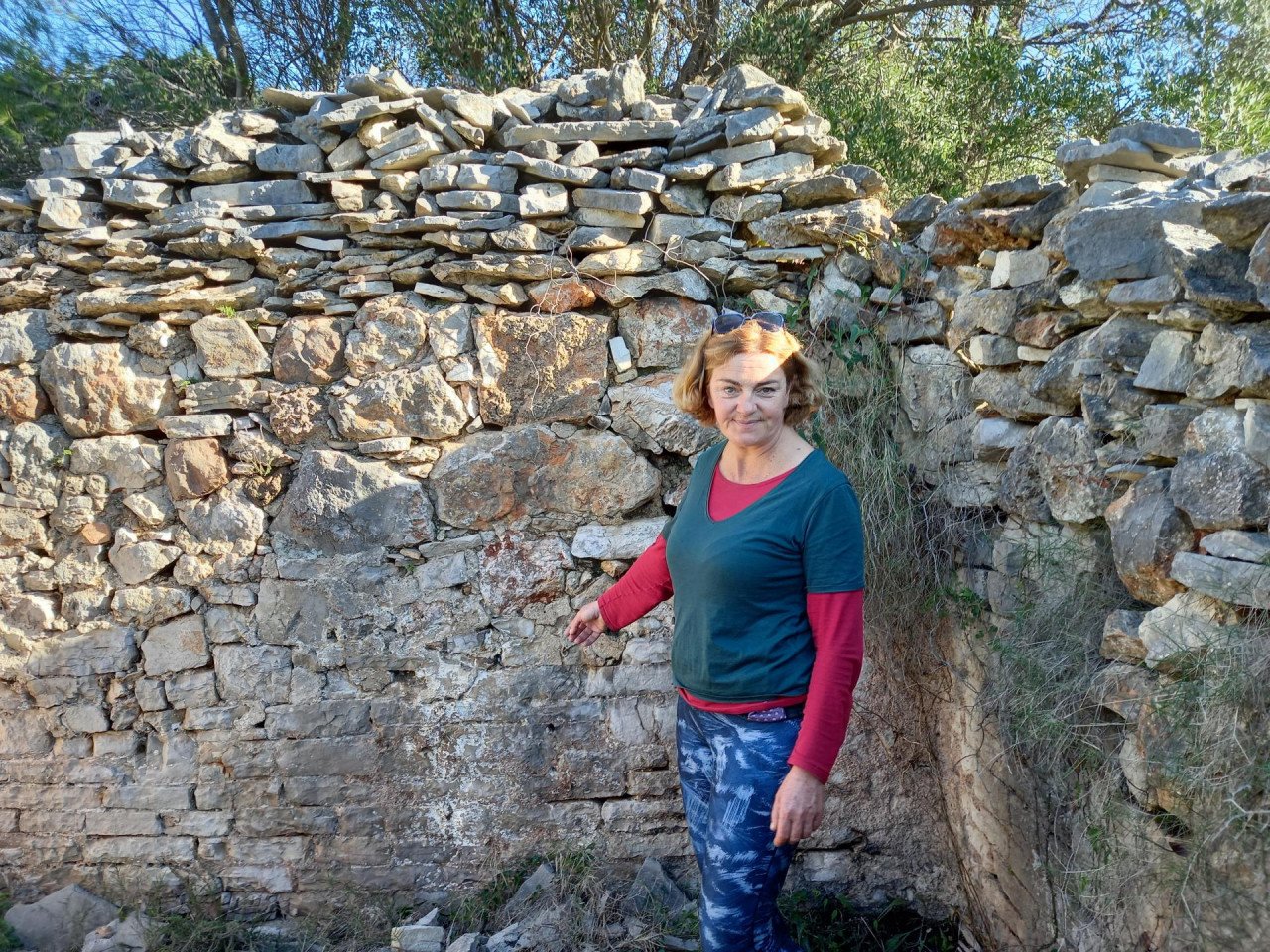
Mirko Crnčević
"On the mainland, we see a large scale luxury Roman farm building whose walls are exceptionally well preserved, and by their construction, we can conclude that they are from an earlier time, meaning from the beginning of the imperial period. We also have pottery fragments possibly dating back to the Roman Republic era, when sea levels were lower than they are now.
The coastal hiking trail passes through an ancient cistern, which on the one hand, is very unstable and will eventually collapse if protection measures are not taken. In the sea, there are structures of walls, floors made of mosaics, terraces, plateaus, and small breakwaters that served in everyday life," adds Katunarić Kirjakov.
On the other side of the bay are ancient tombs, so from everything seen and the findings of vessels from the Early Roman period, it can be preliminary concluded that the site is from the first century BC to the fourth or fifth century AD. Such economic facilities have survived for a long time; they had fertile soil in the hinterland, streams on dry land, drainage canals, and communication with the world took place correctly.
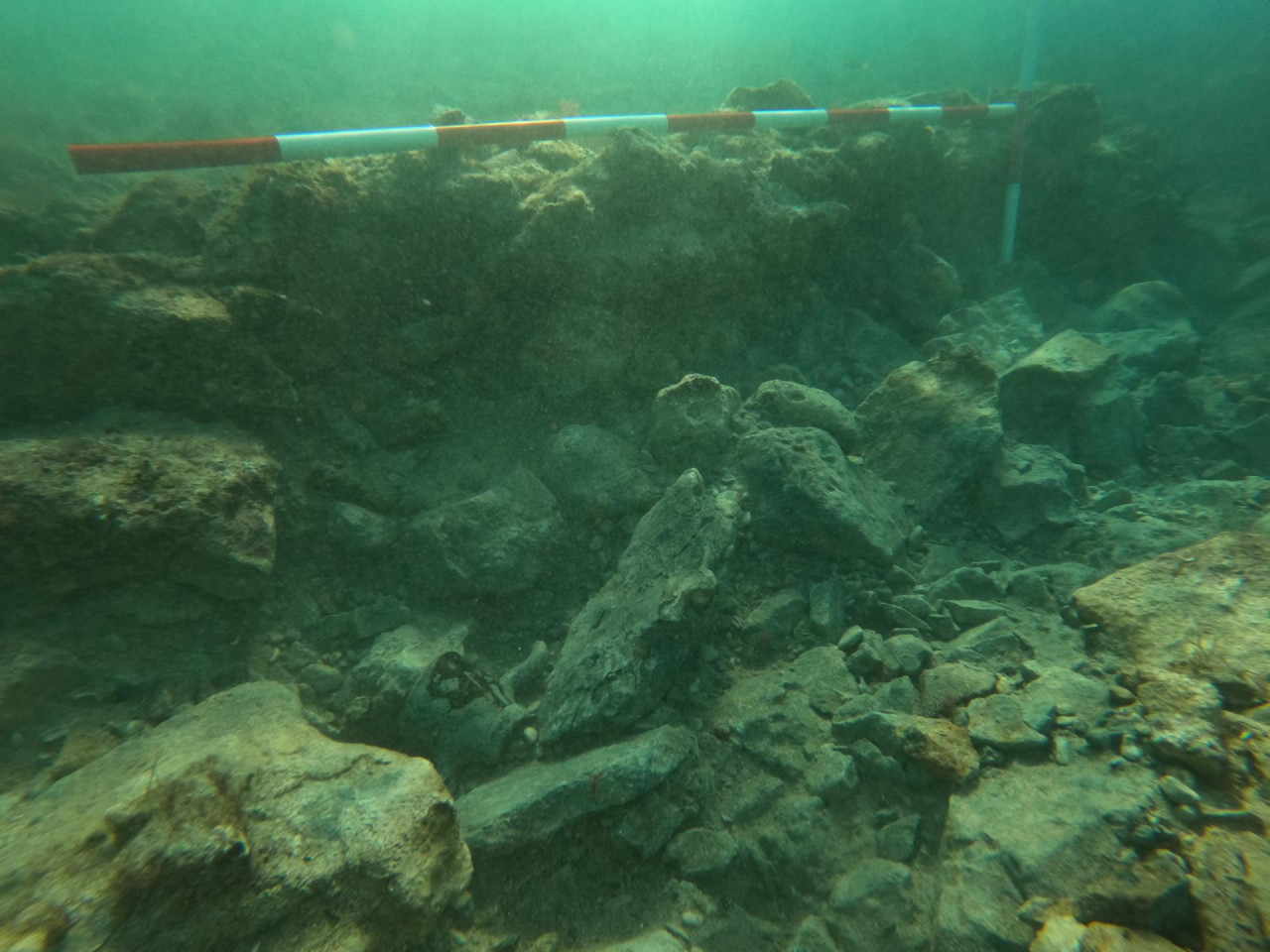
Vedran Katavic
These springs of water are still visible in the sea, and it is brackish; let's say that in antiquity, all the conditions for a beautiful life in that valley, in that bay, were met."
Professor Katunarić Kirjakov's team moved to Stari Grad to continue the earlier research.
"In the area of Bonj/Kamareta, we are exploring the only visible original part of the ancient coast in the Stari Grad bay because it was upgraded and built elsewhere over time. We already have a lot of finds there - fine Hellenistic wine drinking vessels, tableware, amphorae from Greece and Spain, which confirms that the city was connected to the whole rich world at that time."
For more, make sure to check out our dedicated lifestyle section.
Jelsa Tackles Light Pollution in Effort to Become International Dark Sky Community
February 3, 2022 - Harmful outdoor lighting fixtures were removed from a park in the centre of Jelsa, getting the town on Hvar island a step closer to becoming the first International Dark Sky Community in Croatia
The spotlights in question have a colour temperature of 6500 K which is considered detrimental to local wildlife - birds, nocturnal insects, bats, and even plants. They were installed on palm trees in the park and turned upwards, making them a light pollutant of the night sky, reports the Croatian Astronomical Union.
The Croatian Astronomical Union has been collaborating with Jelsa Municipality and the local tourist board for over a year in order to help Jelsa achieve high standards of protection against light pollution. Jelsa is now a step closer to becoming the first International Dark Sky Community in Croatia and south-east Europe at large.

Hrvatski astronomski savez - Facebook
In December 2021, the International Dark-Sky Association (IDA) accepted the motion of Jelsa Municipality to be declared an International Dark Sky Community. A few days ago, IDA delivered a favourable opinion and it’s now only a matter of time before Jelsa is granted the coveted title.
As defined by IDA, an International Dark Sky Community is ‘a town, city, municipality or other legally organised community that has shown exceptional dedication to the preservation of the night sky through the implementation and enforcement of a quality outdoor lighting ordinance, dark sky education and citizen support of dark skies. Dark Sky Communities excel in their efforts to promote responsible lighting and dark sky stewardship, and set good examples for surrounding communities.’
Hvar and Jelsa Primary School Students Design New Calendar
December 22, 2021 - For several years now, the Hvar Tourist Board has been preparing wall calendars, which are recognized as tourist souvenir that wants to have more and more domestic and foreign guests. This year, Hvar and Jelsa primary school students were selected as the artists.
Every year, over 1,500 calendars are distributed, which are the work of Hvar artists. For this year, students from the Hvar Primary School and the Jelsa Primary School - Sveta Nedjelja Regional School were selected as artists from the Hvar Tourist Board, reports HrTurizam.hr.
The Tourist Board of the City of Hvar would like to thank all the Hvar and Jelsa Primary school students and teachers of the Elementary School Hvar with the principal Mrs. Nada Jeličić, as well as the students of the Sveta Nedjelja Regional School with their teacher Mrs. Katija Balić, who made a great contribution to the creation of calendars with their paintings. Many thanks also go to Ivan Zaninović - Grande Design, who managed to combine all the paintings into a beautiful whole, and the town of Hvar.
“This year the idea was to create something special, so we chose students from the Hvar Elementary School and the Jelsa Elementary School - Sveta Nedjelja Regional School as artists. Through children's imagination and their view of the town of Hvar and Holy Sunday, a "top work of art" was created that will decorate a large number of walls in 2022 after the first reactions of Hvar residents, says Petar Razović, director of the Hvar Tourist Board.
Nada Jeličić, director of Hvar Elementary School, said she was especially pleased with another successful collaboration between the Hvar Tourist Board and Hvar Elementary School, where they want to include all students in the tourist promotion of Hvar, and show how the youngest Hvar residents see the beauties of their city.
The Tourist Board of the town of Hvar ends this year's promotion of the destination and the tourist year by making a calendar, which was certainly one of the "special" and we can say successful because a total of 70% of tourist traffic from 2019, ie. 116,000 arrivals and 520,000 overnight stays were realized in the area of the town of Hvar.
For all who want to enjoy the work of the youngest Hvar artists, the calendar is available in the office of the Tourist Board of the town of Hvar, and is also available in digital form here.
For more, check out our lifestyle section.
Jelsa Tourist Board Launches Project "Loyalty Program for Renters"
November 26, 2021 - With the aim of helping private rental owners in the town to prepare in the best possible way for the following summer season, the Jelsa Tourist Board launches a project that will offer discounts and benefits for partners, called the ''Loyalty Program for Renters''.
The project "Loyalty program for renters" of the Tourist Board of Jelsa will offer a number of benefits and discounts for arranging accommodation units, equipping facilities, arranging gardens and yards, and private renters will provide better and better preparation for the upcoming tourist season.
The "Loyalty program for renters" works on the principle of a card that renters will be able to pick up at the office of the Tourist Board of Jelsa, reports HrTurizam. Given the large share of private accommodation in the Municipality of Jelsa, this method jointly contributes to increasing the quality of the tourist offer and encouraging local consumption. The cardholder must be registered in the eVisitor system and have all debts settled.
The Tourist Board of the Municipality of Jelsa invites all companies and crafts that are engaged in economic activities and offer products related to tourism (construction, equipment, works, aesthetics ...), to apply and get involved in the project as partners. The deadline for joining this project is December 10, 2021, after which renters will be invited to pick up their cards at the office of the Tourist Board of Jelsa.
Interested partners should submit an application form in which the required information is entered. By completing it, the partner undertakes to participate in the project until its revocation. Discounts and benefits provided by partners can be easily changed throughout the year, by sending an e-mail toThis email address is being protected from spambots. You need JavaScript enabled to view it. with new information. The project is permanent, and partners who want to activate later in this project are welcome, and you only need to send the completed application form to the specified email address.
The cards are in the name and surname of the landlord, are not transferable to other persons, and can be picked up upon presentation of an identity card. The list of partners and contracted benefits for renters can be found on the tab, whereby simply scanning the QR code, the landlord can see current benefits and discounts at any time. Also, a list of all current offers will be on the official website of the Jelsa Tourist Board.
THE APPLICATION FORM is located at the LINK.
The application form should be sent exclusively to the email address: This email address is being protected from spambots. You need JavaScript enabled to view it. or delivered in person to the office of the Tourist Board of the Municipality of Jelsa.
For more, check out our business section.
Digital Nomads Discover Remnants of Famous Jelsa Bench Tourism
November 1, 2021 - The Jelsa bench is probably the most famous in all Dalmatia, very much on the digital nomad trail, but sadly a shadow of what it once was.
A Dalmatian friend in luxury tourism once described the moment he understood his market and the opportunity completely.
In an olive grove and an olive oil tasting and lunch for wealthy New York clients, one of them marvelled at the fresh lemons on a nearby tree.
"Do you think I might pick one of those lemons," he asked my friend after he noticed my friend watching him. A lemon was plucked from the tree.
"You know," said the rich New Yorker at the end of the week, "the highlight of this excellent trip was picking that lemon. Living in New York, I just never had the experience of picking a lemon from a tree before."
Simple pleasures, taken for granted by locals, which cost nothing. Croatia, your safe, authentic lifestyle destination.

I feel the same way about the (now) famous Jelsa bench.
The original Google, the island Wikipedia, call them what you will, but the local male elders of a certain age, and at a certain time of day, would convene on the bench each day to put the world to rights. And not just in Jelsa, but most Dalmatian towns and villages.
It was an authentic way of life, and one which was admired by many tourists. Life on the bench, a symbol of Croatia, your safe, authentic lifestyle destination.
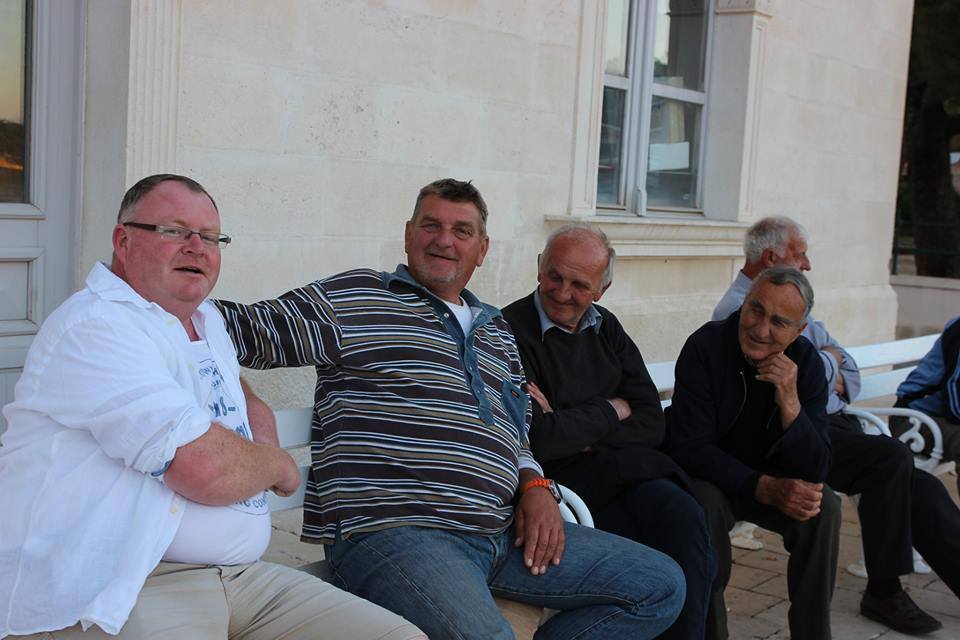
After only 13 years living on Hvar, the unthinkable happened - an invitation from the village elders to sit with them on the bench! This was kind of a big deal, and many locals were shocked that I had received the invitation so soon after my arrival in Jelsa. For 13 years is the blink of an eye in bench years.
I had perhaps been a little obsessive about the Jelsa bench over the years, monitoring its incredible versatility and international appeal.
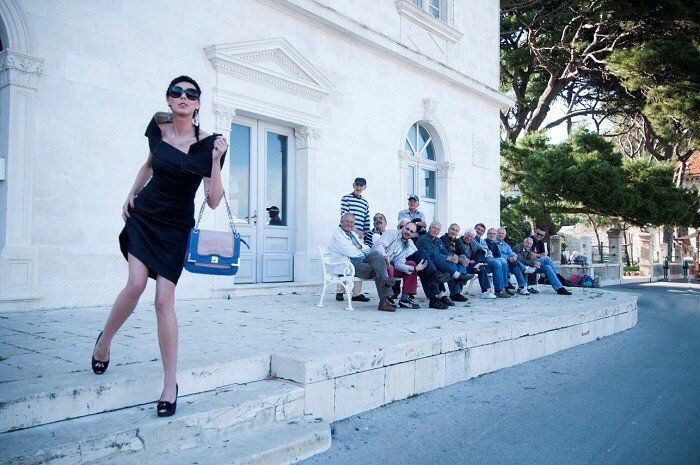
Czech models used the bench occupants as background models in their Hvar photo shoots.
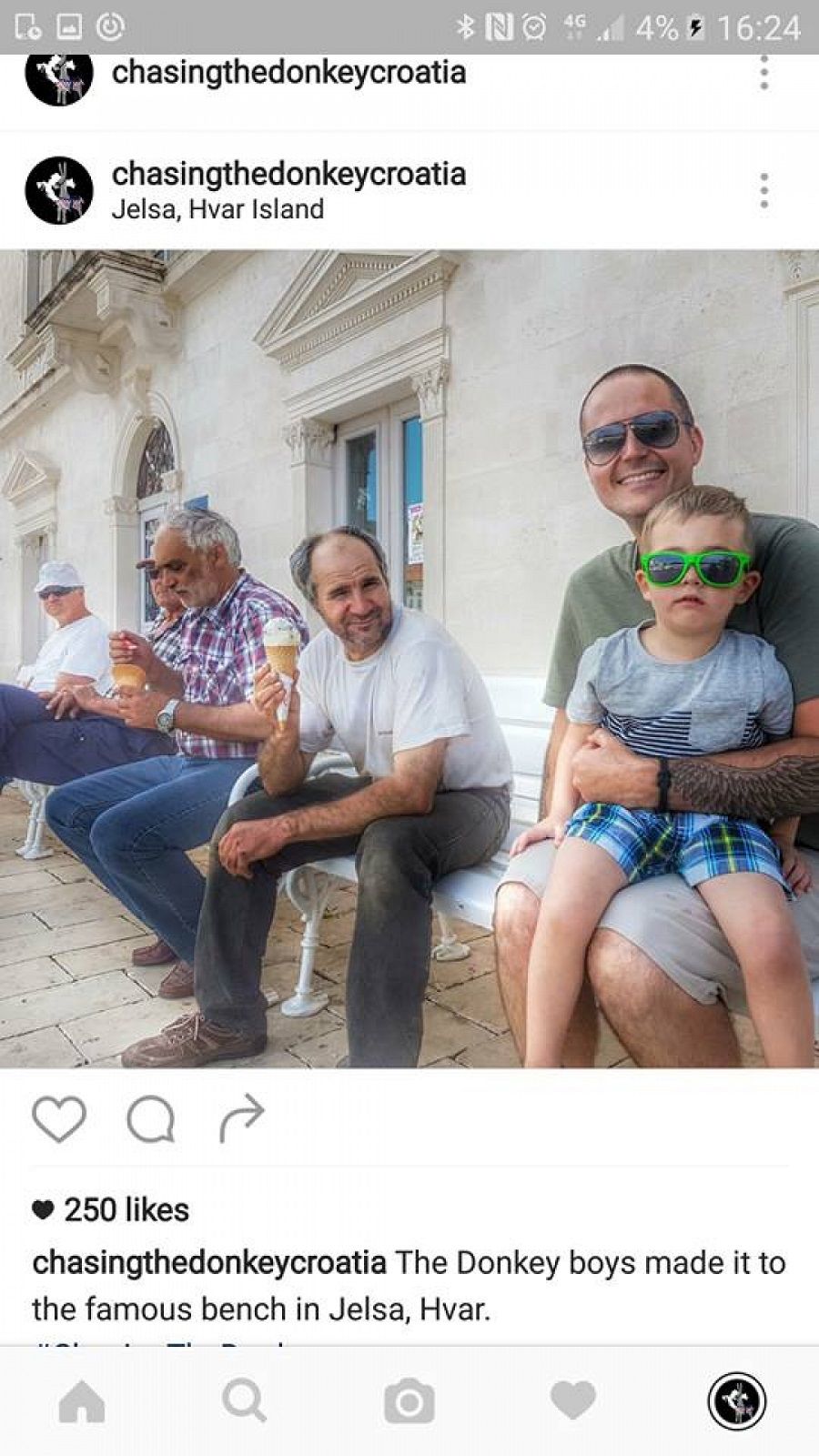
Australian bloggers travelled to Jelsa to take selfies on the hallowed bench.
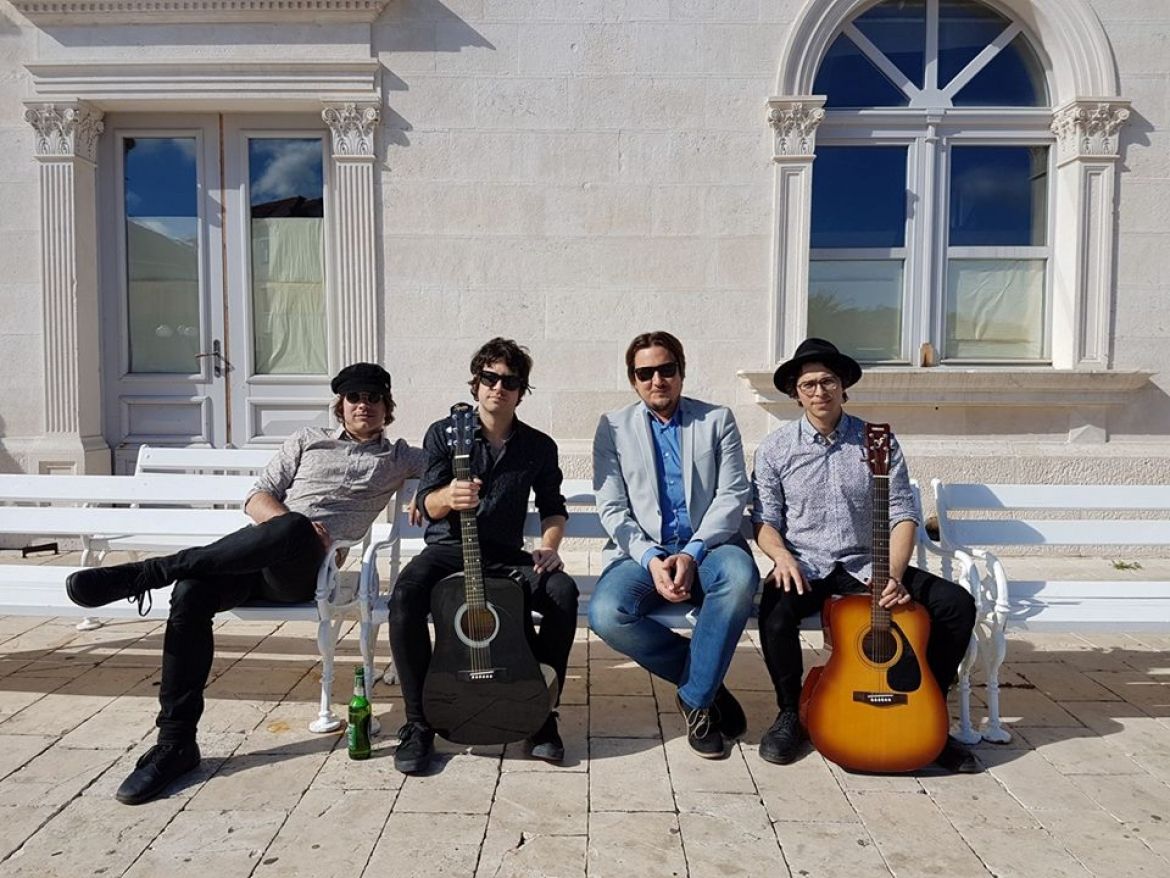
Bands jetted in from California to play live concerts on the bench.
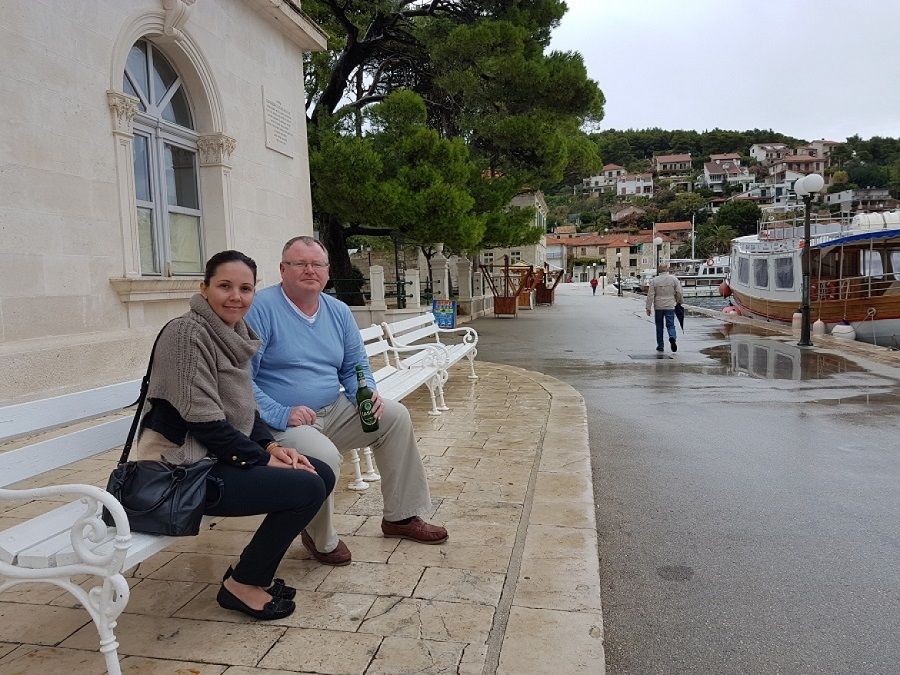
Others travelled on holiday from Sydney, and then took the ferry to Hvar for the sole purpose of sitting on the Jelsa bench.
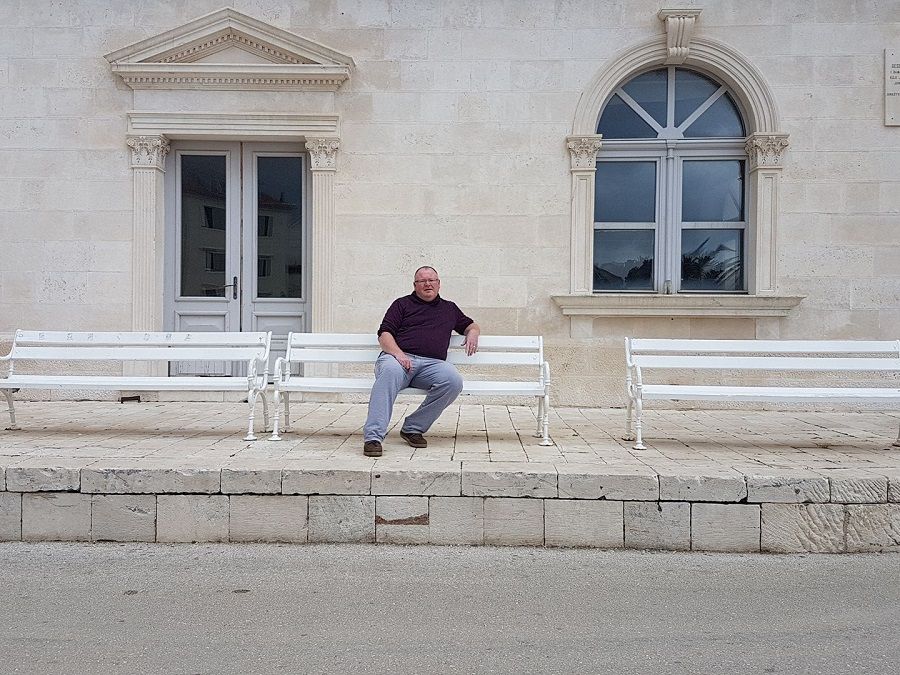
My most creative moments came when I sat alone on the bench, harnessing the aura of the collective IQ of its regulars.
And then one day, the bench was tossed aside in the name of progress. A concession was given to a company to open a restaurant in the Gradska Kavana behind the bench, and the outside space the bench had sat on for generations was given to the restaurant as part of its outside space. It was a concession which led the mayor to announce he was suing me in a public meeting in Vrboska, as you can see above. I am still waiting for the promised lawsuit some three years later.
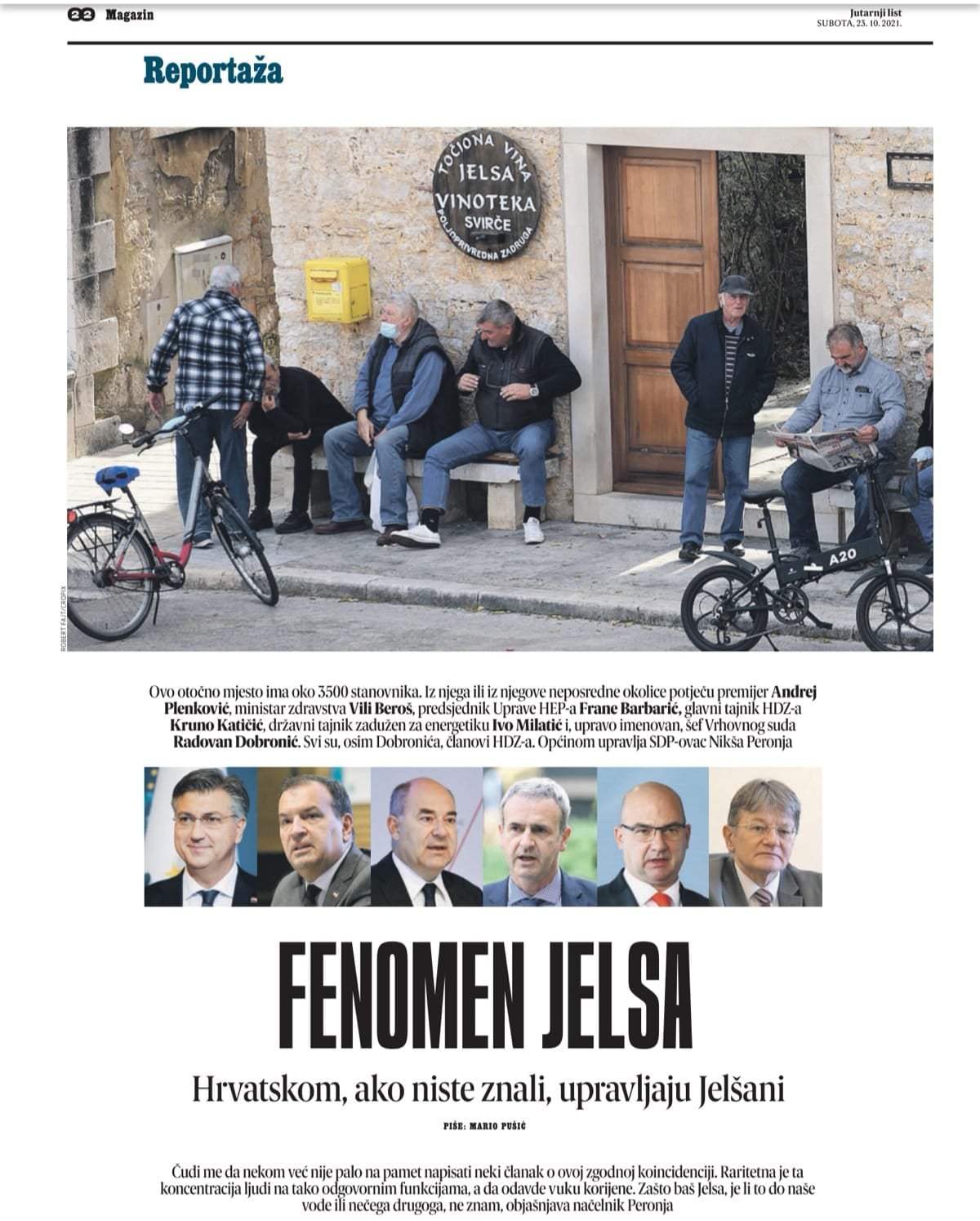
But the Jelsa Bench in exile continued to make the news, featuring as the lead story in the national media about The Jelsa Phenomenon, showcasing the influential people who hailed from Jelsa. These included the current Prime Minister, Health Minister, and Head of the Supreme Court. But the lead photo in the newspaper? The academic colossus of the bench in exile.
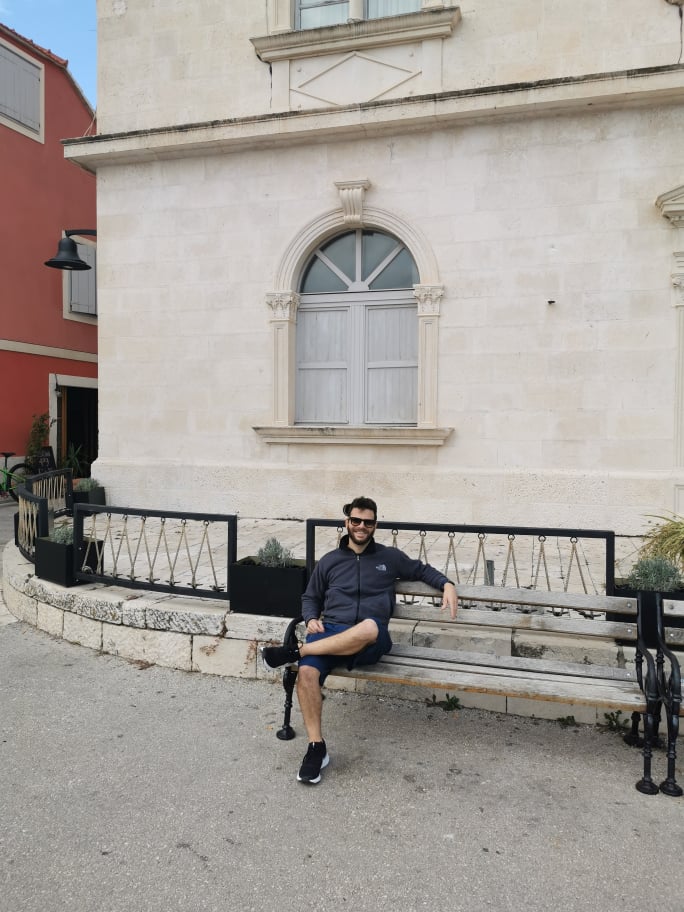
An American digital nomad friend arrived in Jelsa last night. Among many other things, he confessed to being a little intrigued by the Jelsa bench, promising to find out the latest, as well as sending back a selfie.
And what a disappointment, as what passes as the Jelsa bench these days is just a shadow of its former self, as well as being located now on the road.
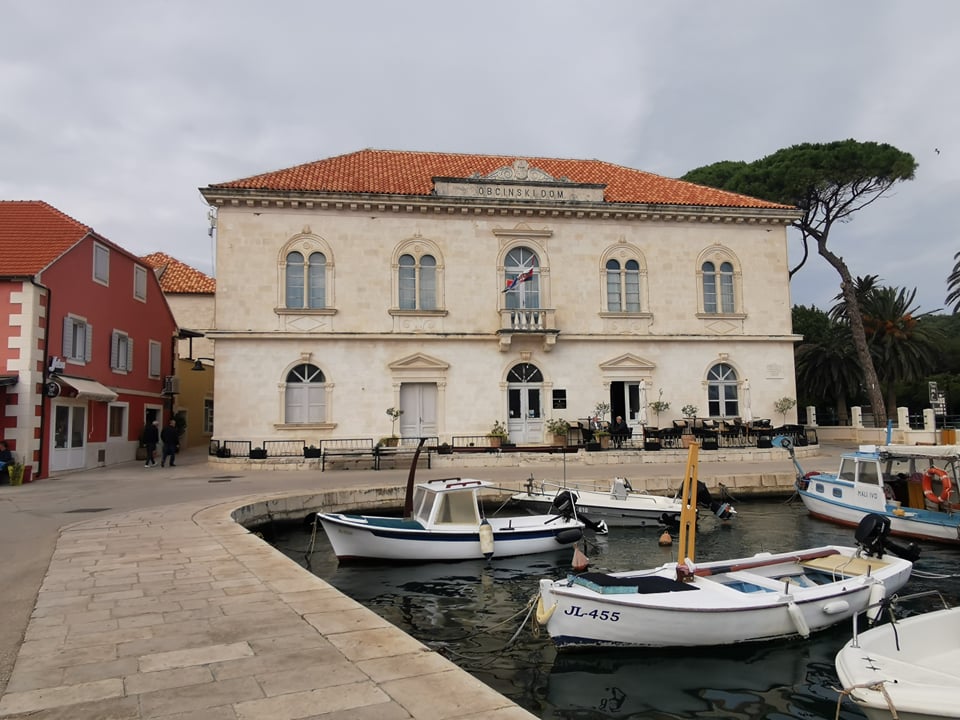
The weather-beaten bench on the road is a far cry from its previous majestic position looking out to sea. That previous majestic position is now occupied by th restaurant
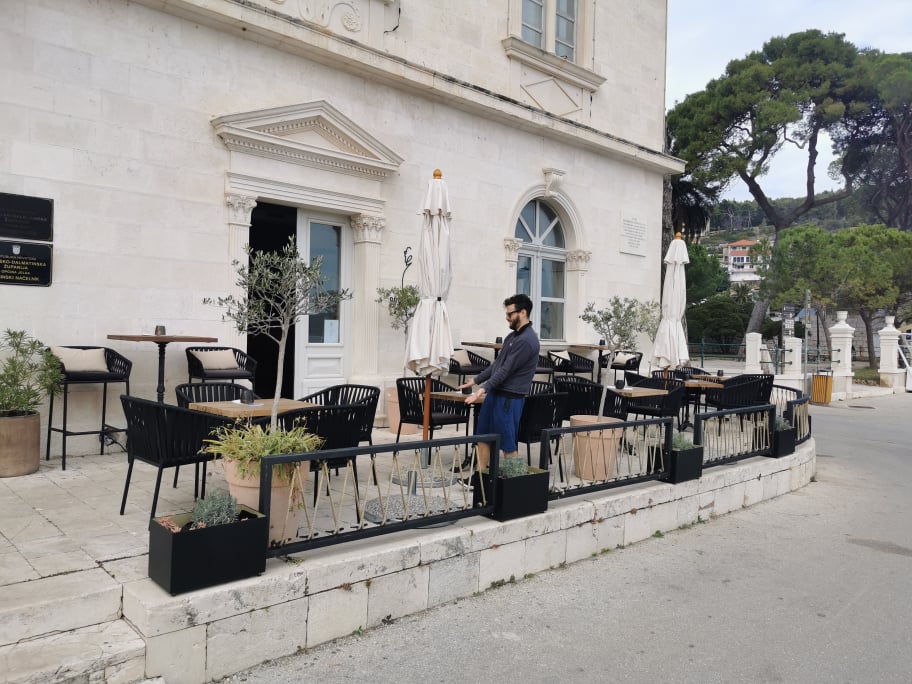
A fence has been erected, with the bench very much on the outside on the street below.
The Jelsa bench in exile will have to adapt, but it is a shadow of its former glory.
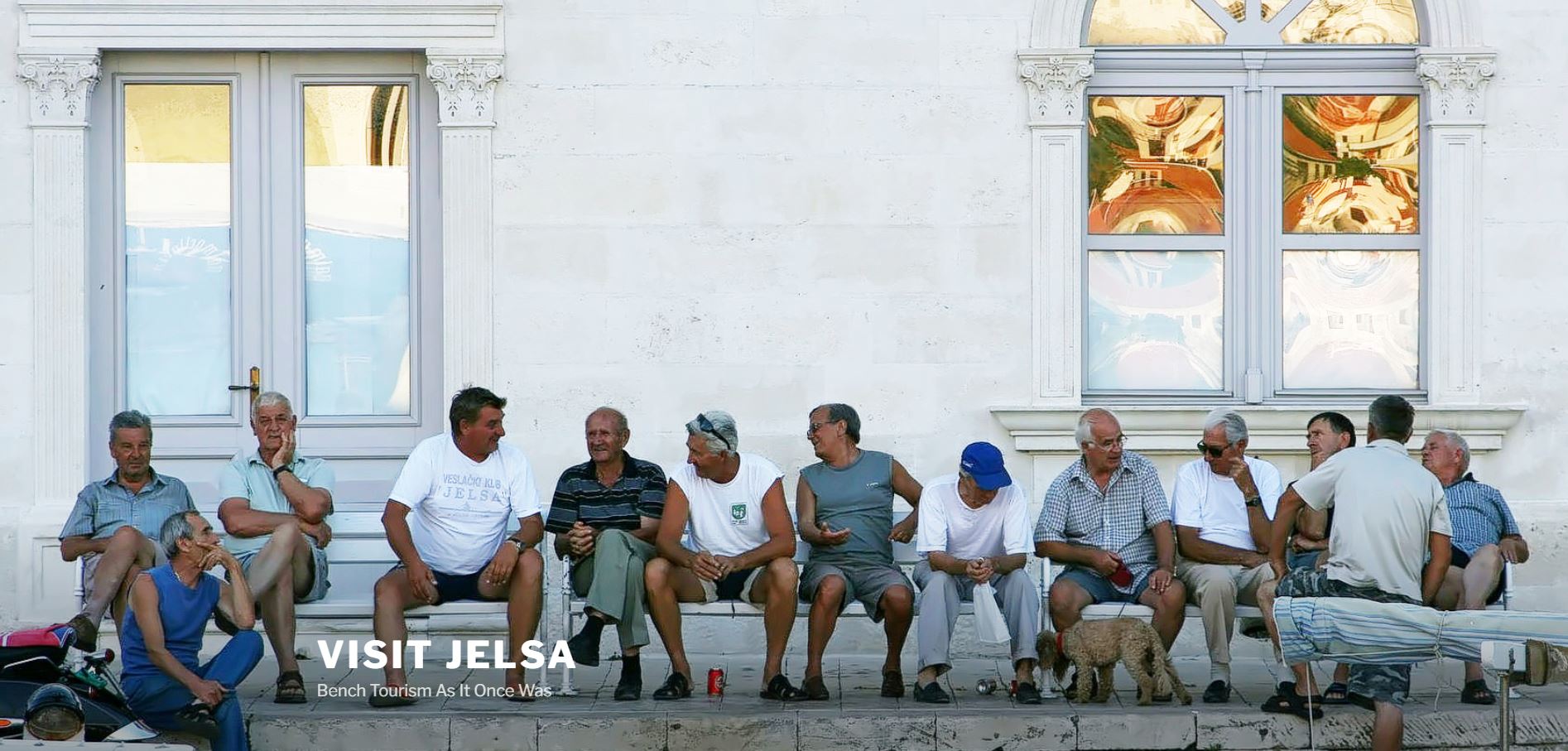
To learn more about Jelsa tourism beyond the bench, visit the TC Jelsa in a Page guide.
Jelsa Wine Festival Returns After Last Year's Break
August 26, 2021 - After a year-long hiatus from the pandemic, one of the most popular and traditional events in the town of Jelsa on the island of Hvar marks its long-awaited return. The Jelsa wine festival starts tomorrow and includes sports, cultural activities, a great gastronomic offer, and of course, the best from its wineries.
As written by Turističke Priče, the first Jelsa wine festival was held back in 1952 on the initiative of the community of the Cooperative Association of Jelsa called the District Cooperative Meeting. In 1954, Cooperative Day was held, and since 1956, this event has been called the Wine Fair or Cooperative Rally. The Wine Fair in 1966 was held on August 14 and that day was declared the Day of Tourism in Jelsa. The festival has been held for years in the first half of August, from Friday to Sunday. The crowd would start in the morning and last until dawn the next day. Huge quantities of wine were poured because the idea was to free the taverns by selling old wine for the new one that will come with the upcoming harvest.
This year's Wine Festival is held on August 27 and 28 and in recent years this event has returned to its original purpose: to be a cheerful event to promote Hvar wines, especially the best in the Jelsa ring, a wine-growing region where we find many original varieties of islands such as Bogdanusa, prča, plavac mali, but also the popular international cabernet sauvignon, merlot, and syrah, and thus various wines, from white and red, rosé, to the popular opol and prosecco.
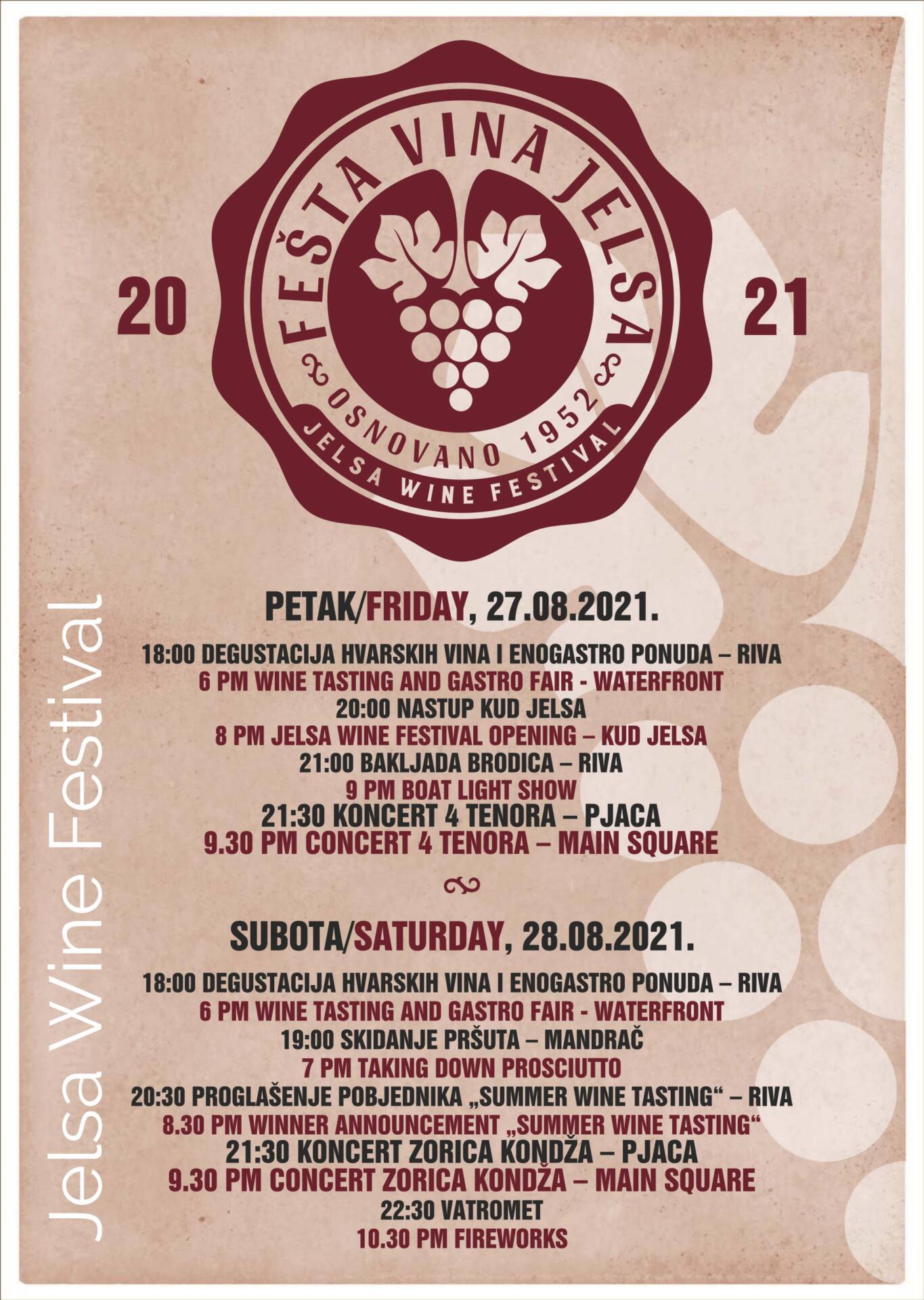
Jelsa Wine Festival
For the last thirty years, these wines have stood out for their quality, won prizes in competitions, and delighted guests for whom the Wine Festival is a real opportunity to taste and feel the differences between wines from the southern slopes of the island, positions from Jelsa slopes and valleys and fields by the sea. The wine festival is an experience that tourists remember - the sun and the sea have long been the only assets of the island, but also tradition, wine, gastronomy, Dalmatian songs... the spirit of the Mediterranean as it once was.
Various sports and entertainment competitions have been announced: water polo matches are played in the port, rowing competitions are held, international regattas as well, and prosciutto is removed from the top of a ten-meter-high mast. Everything is, of course, spiced with a gastronomic offer and accompanied by concerts. This year, Four Tenors and Zorica Kondža are in charge of good music.
For the third year in a row, in cooperation with the Hvar Winemakers Association and the Wine Stars project, a Summer Wine tasting by Wine Stars is held as part of the Jelsa Wine Festival, with an emphasis on original varieties and what makes them different from other wine regions. Book the last weekend in August for Jelsa where the hosts invite you and guarantee good fun. This year's program will be conducted in accordance with current epidemiological measures and the entire program can be found at this LINK.
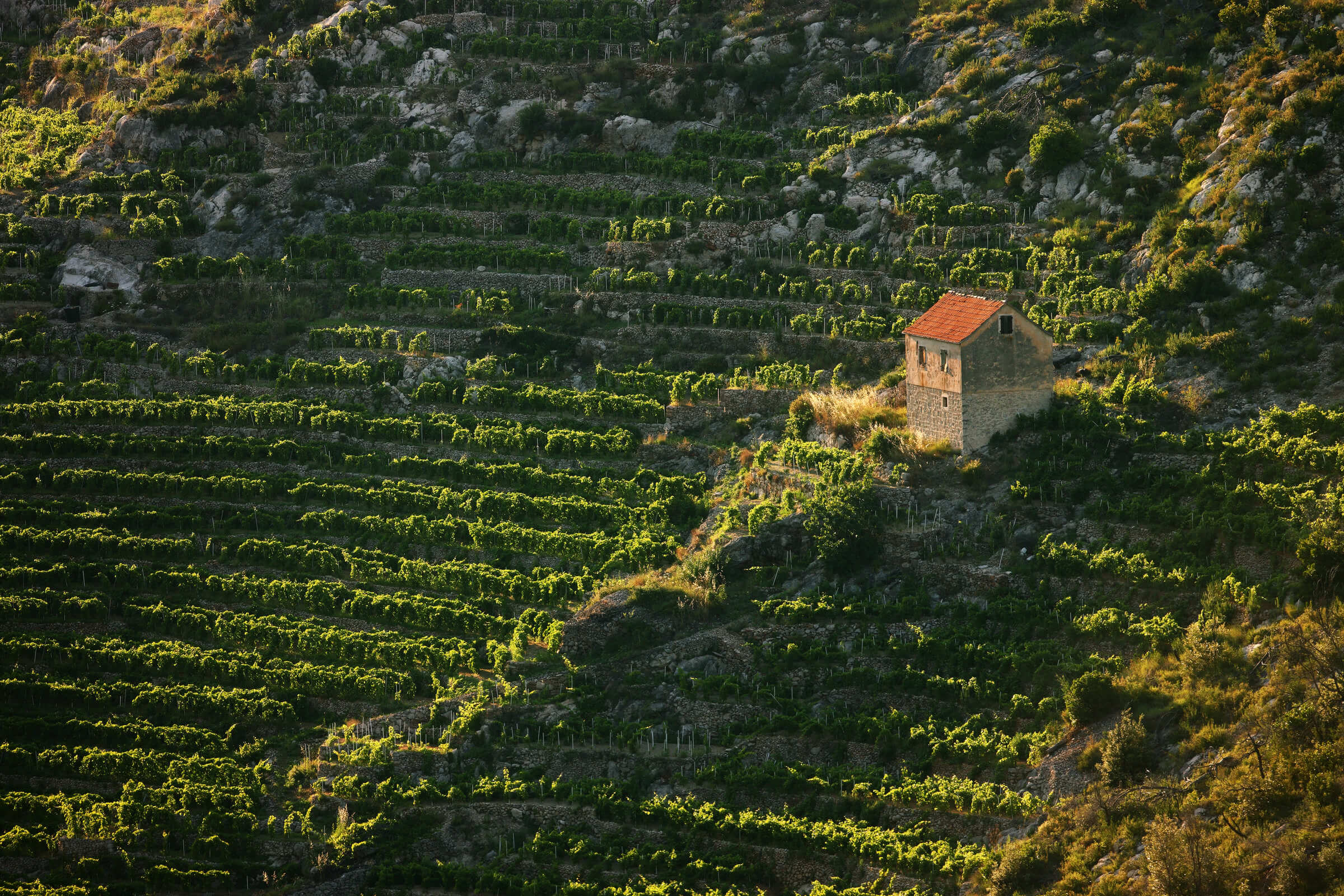
Vineyard on the hills of Jelsa (Photo: Mario Romulić)
After the wine festival, when you are in Jelsa, be sure to look up and discover the starry sky. Apart from the sun and the sea and top wines, Jelsa also offers tourists a starry sky, and the stars are disappearing in modern times precisely because of light pollution, and observing the starry sky is becoming a tourist attraction that you cannot often see.
The stars will be the brightest tourist product of Jelsa, which should acquire the status of the International Dark-Sky Community by the end of the year and become the first municipality/city in Croatia to proudly bear that title. This title confirms Jelsa as a destination that has an exceptional quality of the night sky and respects high environmental standards in terms of light pollution, which together make a big step towards creating an astro-tourist offer in the area of Jelsa.
Croatian wines and grapes are among the best in the world, and you can find more information about them in Total Croatia’s Guide to Croatian Wine HERE. Now in your language!
Jelsa is a slice of safe, authentic lifestyle heaven on Croatia’s premier island, with wine and beach treasures galore. Everything you need to know about Jelsa, you'll find it in our Total Croatia's Jelsa on a Page HERE.
Follow the latest travel updates and COVID-19 news from Croatia HERE.
For more on travel in Croatia, follow TCN's dedicated page.


